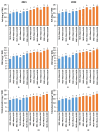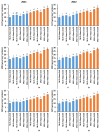Synergistic Effects of Zinc Oxide Nanoparticles and Moringa Leaf Extracts on Drought Tolerance and Productivity of Cucurbita pepo L. Under Saline Conditions
- PMID: 40006803
- PMCID: PMC11860005
- DOI: 10.3390/plants14040544
Synergistic Effects of Zinc Oxide Nanoparticles and Moringa Leaf Extracts on Drought Tolerance and Productivity of Cucurbita pepo L. Under Saline Conditions
Abstract
This study investigated the combined effects of zinc oxide nanoparticles (Nano-Zn) and moringa leaf extract (MLE) on squash plants grown under water stress conditions in saline soil during 2021-2022. The research compared full irrigation (100% ETc) with water deficit conditions (60% ETc). While water deficit negatively impacted plant growth, yield, and various physiological parameters, the sequential application of Nano-Zn (at 50 or 100 mg L-1) with MLE (3%) significantly mitigated these adverse effects. The combined treatment proved more effective than individual applications, enhancing growth parameters, photosynthetic efficiency, and antioxidant systems. The treatment particularly improved stress tolerance by increasing protective compounds like soluble sugars and amino acids while reducing harmful H2O2 levels. The study concluded that sequential application of 100 mg L-1 Nano-Zn with MLE was optimal for enhancing squash performance under drought stress, with 50 mg L-1 Nano-Zn plus MLE as the second-best option.
Keywords: Cucurbita pepo; antioxidants; biostimulants; nano fertilizers; osmoprotectants.
Conflict of interest statement
The authors declare no conflicts of interest.
Figures



References
-
- Abd El-Mageed T.A., Semida W.M., Rady M.M. Moringa leaf extract as biostimulant improves water use efficiency, physio-biochemical attributes of squash plants under deficit irrigation. Agric. Water Manag. 2017;193:46–54. doi: 10.1016/j.agwat.2017.08.004. - DOI
-
- Amer K.H. Effect of irrigation method and quantity on squash yield and quality. Agric. Water Manag. 2011;98:87–111. doi: 10.1016/j.agwat.2011.03.003. - DOI
-
- Yildirim E., Ekinci M., Sahin U., Ors S., Turan M., Demir İ., Dursun A., Kotan R. Improved water productivity in summer squash under water deficit with PGPR and synthetic methyl amine applications. Rhizosphere. 2021;20:100446. doi: 10.1016/j.rhisph.2021.100446. - DOI
-
- Grieve C.M., Grattan S.R., Maas E.V. Plant Salt Tolerance. In: Wallendar W.W., Tanji K.K., editors. Agricultural Salinity Assessment and Management. 2nd ed. ASCE Manual and Reports on Engineering Practice; Reston, VA, USA: 2012. pp. 405–459.
-
- Wanniarachchi S., Sarukkalige R. A Review on Evapotranspiration Estimation in Agricultural Water Management: Past, Present, and Future. Hydrology. 2022;9:123. doi: 10.3390/hydrology9070123. - DOI
LinkOut - more resources
Full Text Sources

